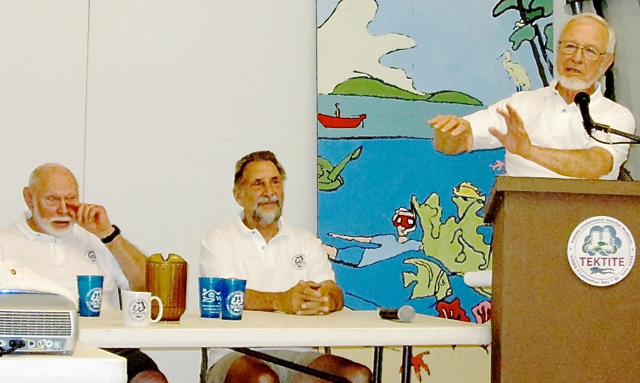
The first Tektite project lasted from Feb. 15 to April 15, 1969, under the waters of Lameshur Bay.
“Our toilet was a 50-gallon barrel cut in half with a stool over it,” John VanDerwalker, 77, said, adding that when the contents got rank, they poured diesel over it and set it on fire.
The underwater habitat often had problems, and VanDerwalker spoke at length about how they had to jury rig the scrubber using a G.E. canister vacuum to keep the carbon dioxide in the air from reaching dangerous levels.
What is now VIERS was the base camp for the underwater Tektite missions. Although the road to VIERS is now partially paved, the location is still one of the most remote on St. John. In 1969, when the first Tektite mission took place, it was truly the back of the beyond. It was easier to get there by boat. Conditions were still primitive when 11 missions on Tektite II happened in 1970.
In the 1960s, the United States was in a race with Russia for space dominance, and Russia was winning. The Tektite project was developed to provide an environment similar to space for training and scientific purposes. It sat about 600 feet below the water’s surface out in Lameshur Bay.
While VanDerwalker in particular was quick with tales about the primitive conditions, Ed Clifton, an aquanaut on Tektite 1 and II missions, spoke at length about the science involved.
“We were lab rats,” Clifton, 80, said, going on to speak about the medical tests the aquanauts had to perform on each other and themselves in the name of science.
While they were monitored full time via cameras by watchers stationed above, the aquanauts also got a good view of the fish that swam by through Tektite’s portholes.
As part of life underwater, the aquanauts headed out of the habitat in dive gear to perform scientific experiments involving undersea life. Clifton showed slides of one experiment that studied the way sand tilefish made burrowing nests. In several experiments, they were able to prove that the fish created a habitat by moving pieces of coral strewn on the ocean floor to one spot to build their nests.
Ian Koblick, 74, had been a Charlotte Amalie High School teacher and then a special assistant to Gov. Melvin Evans when he was tapped for the Tektite project. He was an alternate aquanaut on Tektite I and an aquanaut on Tektite II.
In an interview after the presentations, Koblick pointed out that the V.I. government put up several hundred thousand dollars to support the mission.
“Sparky Puritz was president of the Legislature, he got the money and we went to Washington,” Koblick said, noting that the local government efforts convinced the federal government to locate the project on St. John rather than elsewhere.
He also pointed out in his presentation that telling the decision-makers that rum could be had for 88 cents a bottle didn’t hurt.
Gary Davis, 69, was a V.I. National Park ranger stationed at Cinnamon Bay before he joined the team as a “back up” aquanaut. While the Tektite projects accumulated facts, it also lit the spark for further environmental exploration and protection, he said.
“Today we have small groups of people who are making a huge difference,” he told the 100 or so people who attended the celebration.
VanDerwalker and others said that it the environmental issues are still there.
“We’ll depend on our children to solve it, but we’ve got to inspire them,” he said.





